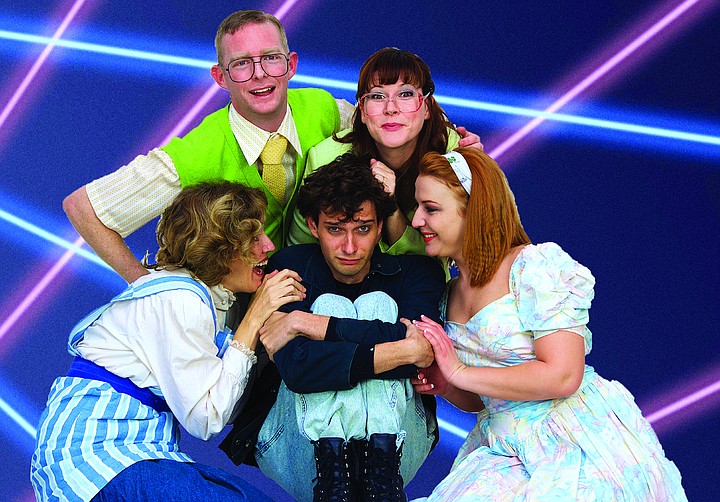 Facebook
Facebook
 X
X
 Instagram
Instagram
 TikTok
TikTok
 Youtube
Youtube

White bassinet, spot-lit center stage. Surrounding darkness makes it seem whiter, even more innocent.
John and Helen, the parents howling over the child, couldn’t be more menacing if they sucked on crack-pipes and wielded chainsaws.
They skreek about child rearing but haven’t a clue. Or even a clue where to find one. Instead of taking a peek under the diaper to determine the baby’s gender, they agree it’s too young to tell. Or name.
John’s an out-of-work lush, who occasionally pierces his vodka-laced fog with what might be an observation. Helen’s a manic-depressive, often switching extremes from one sentence to the next.
Christopher Durang’s Baby with the Bathwater is a horror show. But instead of a rampant reptile or epic cataclysm threatening all humanity, the monsters are John and Helen, who may, as the title suggests, dump the infant along with the soapy suds. And not know the difference.

Throw in Mary Poppins’ free-spirited twin, called “Nanny,” a ditzy, child-napping Cynthia (a dog devoured her toddler), and a self-appointed school psychiatrist, who’s a case study in luno, and Durang peoples the stage with a Jurassic Park’s worth of monsters. They continue one of his pet themes: inferior superiors.
Until mid-Act two, the play’s mostly a string of stark effects, with nothing underneath (Durang’s only answer, which he repeats four times: parents shouldn’t be “inconsistent”). But then he brings in an older Daisy, still dripping with bathwater. Daisy has had 1700 lovers — the play premiered in 1983 — and does a like number of sessions on a therapist’s couch. Somehow, by age 30, and needing 13 years to reach his Junior year in college, he just might begin anew as himself.
Durang’s tricky. Cartoon and you get the humor but not the pain. Go stark real and the satire falls flat. At Diversionary, director Andrew Oswald creates a kind of adult play pen (enhanced by child-like chalk drawings on the walls of Kristen Flores’ set). This choice honors the script’s many demands and showcases his talented cast.
Amanda Sitton’s Helen is a scream – in both senses. She’s funny as all get-out and, as she prances around assuming she’s in the know, genuinely horrifying.
Shana Wride has never been better (which says a ton). She plays umbrella-toting Nanny as a boundary-free spirit and Mrs. Willoughby, the pseudo-psychiatrist, with an amazingly slippery, and nuanced, insanity.
As written, husband John’s a cipher. But Brian Mackey gives him eloquent physical tantrums — the kind usually seen in a crib. Kailey O’Donnell shows versatility as air-headed, rigid, and mildly enlightened women. And J. Tyler Jones is just right as “Young Man,” – a.k.a. Baby, Daisy, Charles Kuralt. Jones nicely combines sanity and suspicion. As he faces one psychological firing squad after another, the Young Man makes Durang’s other point: somehow children make it to adulthood, even if exposed, at an early age, to lead and Red Dye #2.


White bassinet, spot-lit center stage. Surrounding darkness makes it seem whiter, even more innocent.
John and Helen, the parents howling over the child, couldn’t be more menacing if they sucked on crack-pipes and wielded chainsaws.
They skreek about child rearing but haven’t a clue. Or even a clue where to find one. Instead of taking a peek under the diaper to determine the baby’s gender, they agree it’s too young to tell. Or name.
John’s an out-of-work lush, who occasionally pierces his vodka-laced fog with what might be an observation. Helen’s a manic-depressive, often switching extremes from one sentence to the next.
Christopher Durang’s Baby with the Bathwater is a horror show. But instead of a rampant reptile or epic cataclysm threatening all humanity, the monsters are John and Helen, who may, as the title suggests, dump the infant along with the soapy suds. And not know the difference.

Throw in Mary Poppins’ free-spirited twin, called “Nanny,” a ditzy, child-napping Cynthia (a dog devoured her toddler), and a self-appointed school psychiatrist, who’s a case study in luno, and Durang peoples the stage with a Jurassic Park’s worth of monsters. They continue one of his pet themes: inferior superiors.
Until mid-Act two, the play’s mostly a string of stark effects, with nothing underneath (Durang’s only answer, which he repeats four times: parents shouldn’t be “inconsistent”). But then he brings in an older Daisy, still dripping with bathwater. Daisy has had 1700 lovers — the play premiered in 1983 — and does a like number of sessions on a therapist’s couch. Somehow, by age 30, and needing 13 years to reach his Junior year in college, he just might begin anew as himself.
Durang’s tricky. Cartoon and you get the humor but not the pain. Go stark real and the satire falls flat. At Diversionary, director Andrew Oswald creates a kind of adult play pen (enhanced by child-like chalk drawings on the walls of Kristen Flores’ set). This choice honors the script’s many demands and showcases his talented cast.
Amanda Sitton’s Helen is a scream – in both senses. She’s funny as all get-out and, as she prances around assuming she’s in the know, genuinely horrifying.
Shana Wride has never been better (which says a ton). She plays umbrella-toting Nanny as a boundary-free spirit and Mrs. Willoughby, the pseudo-psychiatrist, with an amazingly slippery, and nuanced, insanity.
As written, husband John’s a cipher. But Brian Mackey gives him eloquent physical tantrums — the kind usually seen in a crib. Kailey O’Donnell shows versatility as air-headed, rigid, and mildly enlightened women. And J. Tyler Jones is just right as “Young Man,” – a.k.a. Baby, Daisy, Charles Kuralt. Jones nicely combines sanity and suspicion. As he faces one psychological firing squad after another, the Young Man makes Durang’s other point: somehow children make it to adulthood, even if exposed, at an early age, to lead and Red Dye #2.
Comments